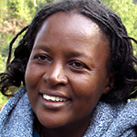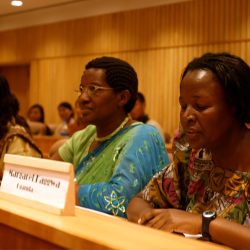Future Generations University Alumni
 LATIGO JAMES, CLASS OF 2014
LATIGO JAMES, CLASS OF 2014
Practicum Summary: Exploring the Significance of Indigenous Knowledge Applications in Resolution of Land Conflicts in Acholiland, Uganda
James’s research practicum explores alternative means toward resolving land conflicts that arose after the return of Acholiland inhabitants who had been forced out of their homes were permitted to return to their homeland. In 1994, in an effort to subdue the Lord’s Resistance Army, the Uganda People’s Defense Force relocated Acholiland inhabitants to Internally Displaced Persons Camps. As the Acholi people returned to their community, they faced many challenges associated with the redistribution of land, including land-grabbing by politicians, civil servants, the business community and local and national investors. In many areas, these disputes resulted in the re-displacement of people, destruction of property, and even the loss of life. In this case communities that once lived together found themselves in the midst of a second war. In order to collect data over a twenty month period, James focused on the lived experiences of the Puranga Clan, which he documented through historical memory practices, interviews, observations, and focus group discussions. After analyzing his data, James constructed the following recommendations to resolving land conflicts in Acholiland: engage lawmakers to identify loopholes in the Land Act and push for amendments that will protect the land and its rightful owners; educate the masses on the practices of land law using radio, schools, and training programs; empower lower courts to handle less contestable rulings; and involve traditional practices as complimentary methods of resolution to formal procedures.
 ENGOLA BRENDA, CLASS OF 2013
ENGOLA BRENDA, CLASS OF 2013
Practicum Summary: People to People Peacebuilding in Karamoja, Uganda: A case study of inter-ethnic dialogues in Moroto and Napak districts
Brenda’s study examines how effective people to people approaches have been in bringing representatives of conflicting groups together in Karamoja to interact in a safe space with the ultimate goal of peace building. The study focuses on interethnic dialogue in the Moroto and Napak districts of Karamoja and investigates the opportunities and considerations for enhancing the efficiency and impact of these interventions. The underlying causes of conflict in Karamoja include cattle raiding, the forging of alliances between clans to take advantage of other clans, and colonial and government policies that exploited or marginalized the sub-region for decades and thus hindered the region’s opportunities for growth and development. By employing qualitative data collection methods, Brenda discovered that 98% of community respondents and 94% of key informants agree that dialogue has contributed to safety, security, and peace in Karamoja. In the past three to four years, the development related issues have been increasingly featured during dialogues, encouraged by shared visions for conflict resolution, prevention, and joint decision making. In order to improve people to people practices, Brenda recommends involving women and youth to expand the likelihood of durable change at the individual and community level. In addition, various stakeholders need to become more aware of conflict and matching conflict analyses with the appropriate interventions. She points out that stakeholders could rush dialogue plans to fit within their work plans and politicians run the risk of exploiting dialogue for their political pursuits. Involving representatives from every sector of the community can help prevent exploitation. Documenting dialogues, building sustainability, involving soothsayers, and transitioning from a military-led law enforcement to civilian-led enforcement are additional recommendations to ensure the success of peace to peace conflict resolution in the years to come.
 KADOMA ANTHONY, CLASS OF 2013
KADOMA ANTHONY, CLASS OF 2013
Practicum Summary: Adapting Poverty Reduction Strategies in Uganda
Anthony focused his practicum study on the Nyamanga Community in the rural area of Kyenjojo district of Uganda, where the majority of community members live in abject poverty. In remote rural areas, smallholder farmers do not have access to vehicles or proper roads to transport their products, and market linkages are weak or nonexistent. They also lack access to financial services and technology to help prevent disease and pests from destroying their crops. In cooperation with members and policy makers, Anthony used in depth interviews and focused group discussions to analyze the different strategies and successes associated with eliminating poverty. Anthony points out that enabling environment and policies at the community level will not help if the impoverished individual is not motivated to propel himself out of poverty. In order for individuals to become motivated and envision a path of out poverty, he recommends that governments set up infrastructure projects such as building roads and searching for markets for agricultural produce, in addition to setting up schools, health facilities, and businesses where people can buy local products. A lot of the time men, the head of the household, will earn a substantial amount of income, but due to patriarchal culture, alcoholism, and poor money management, earnings quickly disappear, without any benefit to the rest of the family. However, the study did show that households in which the wife and husband worked together were more likely to lift themselves out of poverty. The three characteristics needed to fight against poverty that were encountered the most often during this study were hard work, financial discipline, and an independent mind with the effective use of personal judgement. Anthony concludes that to reduce poverty among community members, individuals need to change their behaviors and empower themselves to take responsibility for their own development, diversify sources of income, investing, and to practice being trustworthy, faithful, and hardworking.
 BONGYEREIRE JOY, CLASS OF 2009
BONGYEREIRE JOY, CLASS OF 2009
Practicum Summary: Irish Potato Production in Kisoro District of Uganda
Using field surveys and a desk review of materials gathered from various departments at the Kisoro District Local government, Joy created a socioeconomic analysis of the use of inorganic fertilizers and chemical sprays as opposed to organic practices in the production of Irish potatoes in the Kisoro District of southwestern Uganda, a region with one of the last developed economies in the country. Joy asks key questions in her assessment, including what are the perceived benefits and barriers to adopting organic product of Irish potatoes by farmers in the Kisoro District and what kind of inorganic fertilizers and sprays are they actually using– and what are their effects? Her studies concluded that better farming systems for Kisoro would include rotational farming, mixed farming, organic farming, and fallow system. However, these farming practices require large plots of land, which is not feasible for all smallholders due to the high population density per square mile. Joy recommends instituting demographic controls through the Ugandan Government to ease pressure on natural resources, especially land and forests. She highlights the direct correlation between the use of natural resources and economic health in Uganda, pointing out that careful management and long term planning can lead to increased agricultural and forestry productivity.
 KAGGWA MARGARET, CLASS OF 2007
KAGGWA MARGARET, CLASS OF 2007
Practicum Summary: Feeding Patterns Among HIV Babies at Upper Mulago Hospital in Uganda
The main objective of Margaret Kaggwa’s practicum study is to investigate the problem of breastfeeding among babies who are HIV positive at Upper Mulago Hospital Postnatal and Young Child Clinic in Uganda. The HIV pandemic is widespread in Uganda, and one of the greatest challenges in the field of health. There is significant evidence that the HIV virus can be transmitted from mother to child though breastfeeding. The objectives of the study were to establish the socio-demographic background of the custodians of the babies, recognize feeding patterns among the HIV positive babies, and to identify factors that influence these feeding patterns. Using face to face interviews, focus group discussions, and questionnaires, Kaggwa collected data from mothers, fathers, or other caregivers bringing babies to the postnatal and young child clinic. Inevitably she determined that the majority of babies were aged between 11 and 14 weeks, and below the recommended, or average weight margin. She found that the majority of parents were not subscribing to optimal feeding patterns due to inadequate knowledge of how mixed feeding patterns can affect a newborn, as well as a lack of education on how HIV is spread from mothers to their children.





